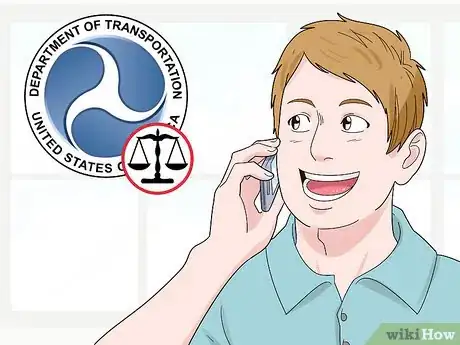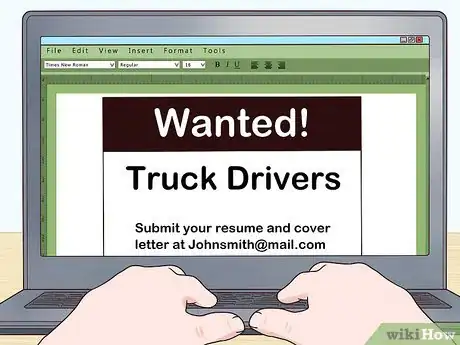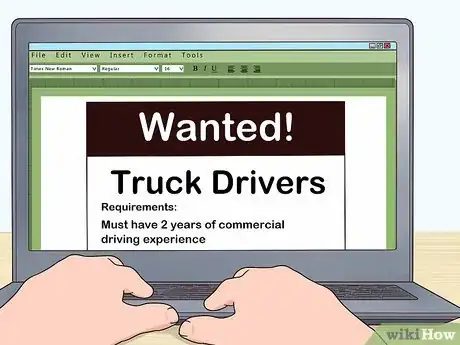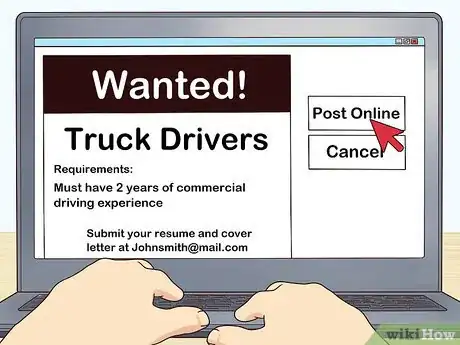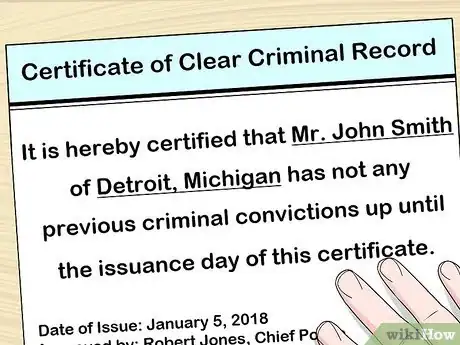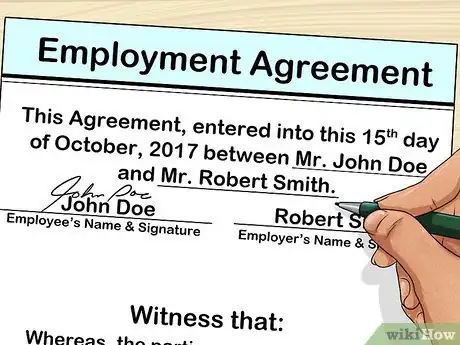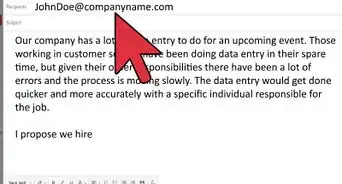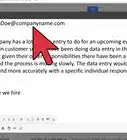This article was co-authored by wikiHow staff writer, Kyle Hall. Kyle Hall works on the content team at wikiHow. He helps manage our team of editors and creates content for a variety of wikiHow projects. Kyle continually looks for new ways to improve the content at wikiHow and make it more helpful and enjoyable for readers. He graduated from Eckerd College in 2015, where he majored in Political Science.
There are 7 references cited in this article, which can be found at the bottom of the page.
This article has been viewed 22,991 times.
Learn more...
Finding new truck drivers isn’t always easy. You can make the hiring process easier on yourself by being specific about what you're looking for and thoroughly vetting all of the candidates for the position. It's also important to look for candidates with the right qualities for a truck driving job, like reliability and professionalism. By being thorough and finding the best candidates for the job, you can save yourself from having to go through the hiring process all over again in the near future.
Steps
Finding Qualified Candidates
-
1Contact your transportation department to find out relevant hiring laws. Some countries and cities have laws about who can work as a paid truck driver. Depending on where you live, commercial truck drivers may need a special license. It's important you find out your local and national laws and regulations before you start the hiring process. Once you've talked to your transportation department, you can look for drivers with the right licenses and qualifications.[1]
- For example, in the United States, commercial truck drivers need to have their commercial driver’s license (CDL) on top of their regular driver’s license.
- In some states you can hire truck drivers as independent contractors, while other states require you to hire truck drivers as full-time employees.
-
2Contact your insurance company to find out their rules for insuring drivers. You’ll need to insure your new truck drivers, and your insurance company may have rules about who they will insure. Before you start looking for drivers, make sure you understand what standards your drivers have to meet in order to be covered by your insurance company.[2]
- For example, your insurance company may only insure commercial drivers who have at least 1 year of commercial driving experience.
- Most insurance companies require drivers to be at least 21. It may cost more to hire young (21-24) or senior (65+) drivers because younger drivers get into more accidents due to limited experience while seniors are the most expensive for insurance companies to pay for medical services after a collision.
Advertisement -
3Create a job ad. Make clear in your ad the hours you expect drivers to work, how much drivers will be paid, and what qualifications are expected of candidates. Type up the job ad on the computer and make sure you proofread it for any errors. Include your contact information or an email or website where candidates can submit their resume.
- If you're not sure how much to pay drivers, take a look at your budget and look at what other companies are offering. You may want to offer more to be competitive.
- When you're coming up with the hours for the job, keep in mind your delivery schedule and any local or national laws that regulate how many hours commercial drivers can be on the road at a time.
- In the job ad, ask candidates to include a resume and cover letter with their application.
- Ask candidates to submit the contact information for their previous 2 employers.
-
4Ask for candidates with truck-driving experience in your job ad. Hiring someone who has already driven a large commercial vehicle for another company is less risky than hiring a driver with no experience. In your job ad, include something like "Must have 2 years of commercial driving experience" or "Commercial driving experience preferred." [3]
- If you're interested in hiring entry-level drivers, mention in your ad that you'll also consider candidates that recently completed a truck driving program at an accredited school.
-
5Post your job ad online. If your company has a website, create a page called “jobs” or “careers” and put the ad on there. Post the ad on multiple job boards, like Craigslist, Indeed, and Simply Hired. You can also share your job ad on social media platforms like Facebook and Twitter.[4]
Vetting Candidates
-
1Run criminal background checks. Depending on your local and national laws, you may be able to hire a third party to prepare criminal background reports on candidates after you get their consent. Search for a consumer reporting agency online and hire them to prepare a report for you. When you get the report, look for red flags like drug or alcohol-related crimes or a lot of driving violations. Stick with candidates who have a clean record and avoid candidates that have driving-related offenses in their report.[5]
-
2Invite promising candidates in for an interview. Ask them about their previous employment experience and ask why they want to be a truck driver. Find out if they have any issues with spending long periods of time driving. Pay attention to how they carry themselves and how professional they seem. You can also ask hypothetical questions to see how candidates would do on the job.
- For example, you could ask candidates “If you’re halfway to your destination and you realize something was left behind at the warehouse, what would you do?”
- You could ask candidates something like "What strengths would you bring to this position?"
- Keep in mind that finding and interviewing candidates for the job can take several weeks or longer.
-
3Look for candidates who are reliable. If a driver isn’t reliable, your shipments could go out late, which could cost you money. When you’re talking to a candidate’s references, ask them about their reliability. If a candidate seems unreliable, they may not be the best fit for your company.[6]
- For example, you could ask their reference "Was Mark late to work a lot?" or "Did Mark take a lot of days off when he worked for you?"
-
4Call each candidate’s references. Hiring a truck driver can be risky because you’re trusting a stranger to be responsible with your truck and equipment. Contacting a candidate’s previous employers for a reference can minimize the risk by giving you an idea of what kind of employee they are. Prepare a list of questions to ask before you give their references a call. Focus on finding out if the candidate is reliable, honest, and hardworking.[7]
- For example, you could ask a candidate's reference "Can you tell me what John's work performance was like when he was at your company?"
- You could also ask something like "What were Sarah's strengths and weaknesses when she worked for you?"
Onboarding New Drivers
-
1Reach out to candidates you want to hire and offer them the position. Call or send them an email congratulating them on getting the job. Explain how much the position pays, what the benefits are, and what their expected hours are. If you're telling the candidate over the phone, follow up your phone call with an email that has all the information about the job in it so the candidate has it for their records.[8]
- Give candidates up to 3 days to accept your job offer.
- Keep the contact information for the other candidates you interviewed in case candidates you offer the job to decline or don't work out.
-
2Have candidates sign an employment contract before they start. The contract should include the position title, compensation, employee benefits, non-disclosure and non-competition clauses, a section on dispute resolution, and both your signature and the employee's signature. Search online for "free employment contract templates" for help putting a contract together.[9]
- Make sure your employment contract follows all applicable laws and regulations. You may want to hire a third party, like a contract lawyer, to review your contract.
-
3Train your new employees. Designate a 2 week training period where your new drivers tag along with your experienced drivers on their routes. If you don't have experienced drivers yet, train your new drivers yourself. Prepare a packet of notes to give new employees that outline specific job expectations and procedures. While new employees are training, offer both constructive criticism and praise.[10]
- For example, if a new driver forgets to log a delivery, you could remind them to do it in the future and explain why it's so important that deliveries are logged on time.
- If you notice a new driver taking initiative or asking a lot of good questions, you could stop them at the end of the day and say "Hey, nice job today."
References
- ↑ https://www.agweb.com/article/tips-for-hiring-truck-drivers-naa-sonja-begemann/
- ↑ https://truckerterritory.progressivecommercial.com/toolbox/hiring-truck-drivers-hire-fire-invest/
- ↑ https://www.agweb.com/article/tips-for-hiring-truck-drivers-naa-sonja-begemann/
- ↑ http://www.truckinginfo.com/channel/fleet-management/article/story/2013/05/9-ideas-to-find-keep-drivers.aspx
- ↑ http://money.cnn.com/2015/01/05/pf/background-checks/index.html
- ↑ https://www.agweb.com/article/tips-for-hiring-truck-drivers-naa-sonja-begemann/
- ↑ https://www.agweb.com/article/tips-for-hiring-truck-drivers-naa-sonja-begemann/
- ↑ https://www.inc.com/jeff-haden/how-to-make-the-perfect-job-offer-9-tips.html
- ↑ https://fitsmallbusiness.com/employment-contract-template/
